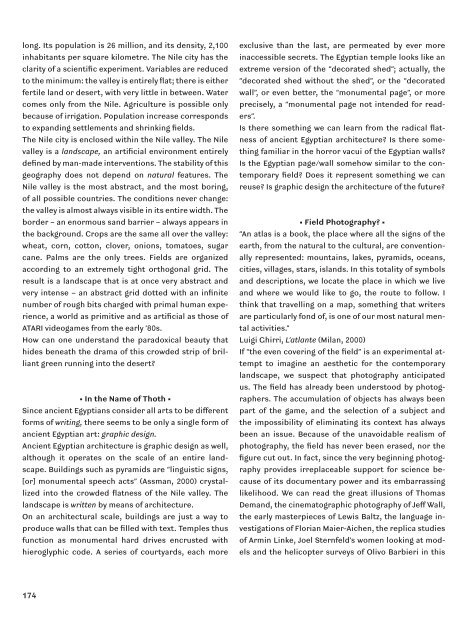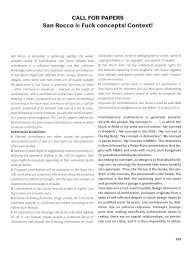CALL FOR PAPERS San Rocco 2: The Even Covering of the Field
CALL FOR PAPERS San Rocco 2: The Even Covering of the Field
CALL FOR PAPERS San Rocco 2: The Even Covering of the Field
You also want an ePaper? Increase the reach of your titles
YUMPU automatically turns print PDFs into web optimized ePapers that Google loves.
long. Its population is 26 million, and its density, 2,100<br />
inhabitants per square kilometre. <strong>The</strong> Nile city has <strong>the</strong><br />
clarity <strong>of</strong> a scientific experiment. Variables are reduced<br />
to <strong>the</strong> minimum: <strong>the</strong> valley is entirely flat; <strong>the</strong>re is ei<strong>the</strong>r<br />
fertile land or desert, with very little in between. Water<br />
comes only from <strong>the</strong> Nile. Agriculture is possible only<br />
because <strong>of</strong> irrigation. Population increase corresponds<br />
to expanding settlements and shrinking fields.<br />
<strong>The</strong> Nile city is enclosed within <strong>the</strong> Nile valley. <strong>The</strong> Nile<br />
valley is a landscape, an artificial environment entirely<br />
defined by man-made interventions. <strong>The</strong> stability <strong>of</strong> this<br />
geography does not depend on natural features. <strong>The</strong><br />
Nile valley is <strong>the</strong> most abstract, and <strong>the</strong> most boring,<br />
<strong>of</strong> all possible countries. <strong>The</strong> conditions never change:<br />
<strong>the</strong> valley is almost always visible in its entire width. <strong>The</strong><br />
border – an enormous sand barrier – always appears in<br />
<strong>the</strong> background. Crops are <strong>the</strong> same all over <strong>the</strong> valley:<br />
wheat, corn, cotton, clover, onions, tomatoes, sugar<br />
cane. Palms are <strong>the</strong> only trees. <strong>Field</strong>s are organized<br />
according to an extremely tight orthogonal grid. <strong>The</strong><br />
result is a landscape that is at once very abstract and<br />
very intense – an abstract grid dotted with an infinite<br />
number <strong>of</strong> rough bits charged with primal human experience,<br />
a world as primitive and as artificial as those <strong>of</strong><br />
ATARI videogames from <strong>the</strong> early ’80s.<br />
How can one understand <strong>the</strong> paradoxical beauty that<br />
hides beneath <strong>the</strong> drama <strong>of</strong> this crowded strip <strong>of</strong> brilliant<br />
green running into <strong>the</strong> desert?<br />
• In <strong>the</strong> Name <strong>of</strong> Thoth •<br />
Since ancient Egyptians consider all arts to be different<br />
forms <strong>of</strong> writing, <strong>the</strong>re seems to be only a single form <strong>of</strong><br />
ancient Egyptian art: graphic design.<br />
Ancient Egyptian architecture is graphic design as well,<br />
although it operates on <strong>the</strong> scale <strong>of</strong> an entire landscape.<br />
Buildings such as pyramids are “linguistic signs,<br />
[or] monumental speech acts” (Assman, 2000) crystallized<br />
into <strong>the</strong> crowded flatness <strong>of</strong> <strong>the</strong> Nile valley. <strong>The</strong><br />
landscape is written by means <strong>of</strong> architecture.<br />
On an architectural scale, buildings are just a way to<br />
produce walls that can be filled with text. Temples thus<br />
function as monumental hard drives encrusted with<br />
hieroglyphic code. A series <strong>of</strong> courtyards, each more<br />
174<br />
exclusive than <strong>the</strong> last, are permeated by ever more<br />
inaccessible secrets. <strong>The</strong> Egyptian temple looks like an<br />
extreme version <strong>of</strong> <strong>the</strong> “decorated shed”; actually, <strong>the</strong><br />
“decorated shed without <strong>the</strong> shed”, or <strong>the</strong> “decorated<br />
wall”, or even better, <strong>the</strong> “monumental page”, or more<br />
precisely, a “monumental page not intended for readers”.<br />
Is <strong>the</strong>re something we can learn from <strong>the</strong> radical flatness<br />
<strong>of</strong> ancient Egyptian architecture? Is <strong>the</strong>re something<br />
familiar in <strong>the</strong> horror vacui <strong>of</strong> <strong>the</strong> Egyptian walls?<br />
Is <strong>the</strong> Egyptian page/wall somehow similar to <strong>the</strong> contemporary<br />
field? Does it represent something we can<br />
reuse? Is graphic design <strong>the</strong> architecture <strong>of</strong> <strong>the</strong> future?<br />
• <strong>Field</strong> Photography? •<br />
“An atlas is a book, <strong>the</strong> place where all <strong>the</strong> signs <strong>of</strong> <strong>the</strong><br />
earth, from <strong>the</strong> natural to <strong>the</strong> cultural, are conventionally<br />
represented: mountains, lakes, pyramids, oceans,<br />
cities, villages, stars, islands. In this totality <strong>of</strong> symbols<br />
and descriptions, we locate <strong>the</strong> place in which we live<br />
and where we would like to go, <strong>the</strong> route to follow. I<br />
think that travelling on a map, something that writers<br />
are particularly fond <strong>of</strong>, is one <strong>of</strong> our most natural mental<br />
activities.”<br />
Luigi Ghirri, L’atlante (Milan, 2000)<br />
If “<strong>the</strong> even covering <strong>of</strong> <strong>the</strong> field” is an experimental attempt<br />
to imagine an aes<strong>the</strong>tic for <strong>the</strong> contemporary<br />
landscape, we suspect that photography anticipated<br />
us. <strong>The</strong> field has already been understood by photographers.<br />
<strong>The</strong> accumulation <strong>of</strong> objects has always been<br />
part <strong>of</strong> <strong>the</strong> game, and <strong>the</strong> selection <strong>of</strong> a subject and<br />
<strong>the</strong> impossibility <strong>of</strong> eliminating its context has always<br />
been an issue. Because <strong>of</strong> <strong>the</strong> unavoidable realism <strong>of</strong><br />
photography, <strong>the</strong> field has never been erased, nor <strong>the</strong><br />
figure cut out. In fact, since <strong>the</strong> very beginning photography<br />
provides irreplaceable support for science because<br />
<strong>of</strong> its documentary power and its embarrassing<br />
likelihood. We can read <strong>the</strong> great illusions <strong>of</strong> Thomas<br />
Demand, <strong>the</strong> cinematographic photography <strong>of</strong> Jeff Wall,<br />
<strong>the</strong> early masterpieces <strong>of</strong> Lewis Baltz, <strong>the</strong> language investigations<br />
<strong>of</strong> Florian Maier-Aichen, <strong>the</strong> replica studies<br />
<strong>of</strong> Armin Linke, Joel Sternfeld’s women looking at models<br />
and <strong>the</strong> helicopter surveys <strong>of</strong> Olivo Barbieri in this




